Principles of Purchases and Supply Management: An Analysis Report
VerifiedAdded on 2022/10/09
|5
|1164
|31
Report
AI Summary
This report provides a comprehensive overview of Purchasing and Supply Management (PSM), drawing on several scholarly articles to examine its evolution and current trends. It discusses the strategic importance of PSM in managing an organization's needs, from manufacturing to consumer stages, and its impact on quality, scheduling, and costs. The report analyzes literature reviews, focusing on the past, present, and future of PSM, and addresses the limitations of existing research, such as outdated data. Key topics include risk management, supplier relationships, and the implementation of effective PSM through action research. The report emphasizes the growth of PSM, its theoretical background, and its application in various disciplines, while also acknowledging areas that require further development. The report highlights the importance of specialists ensuring positive offerings for consumers and the mitigation of risks. The document extensively references several articles on the subject.
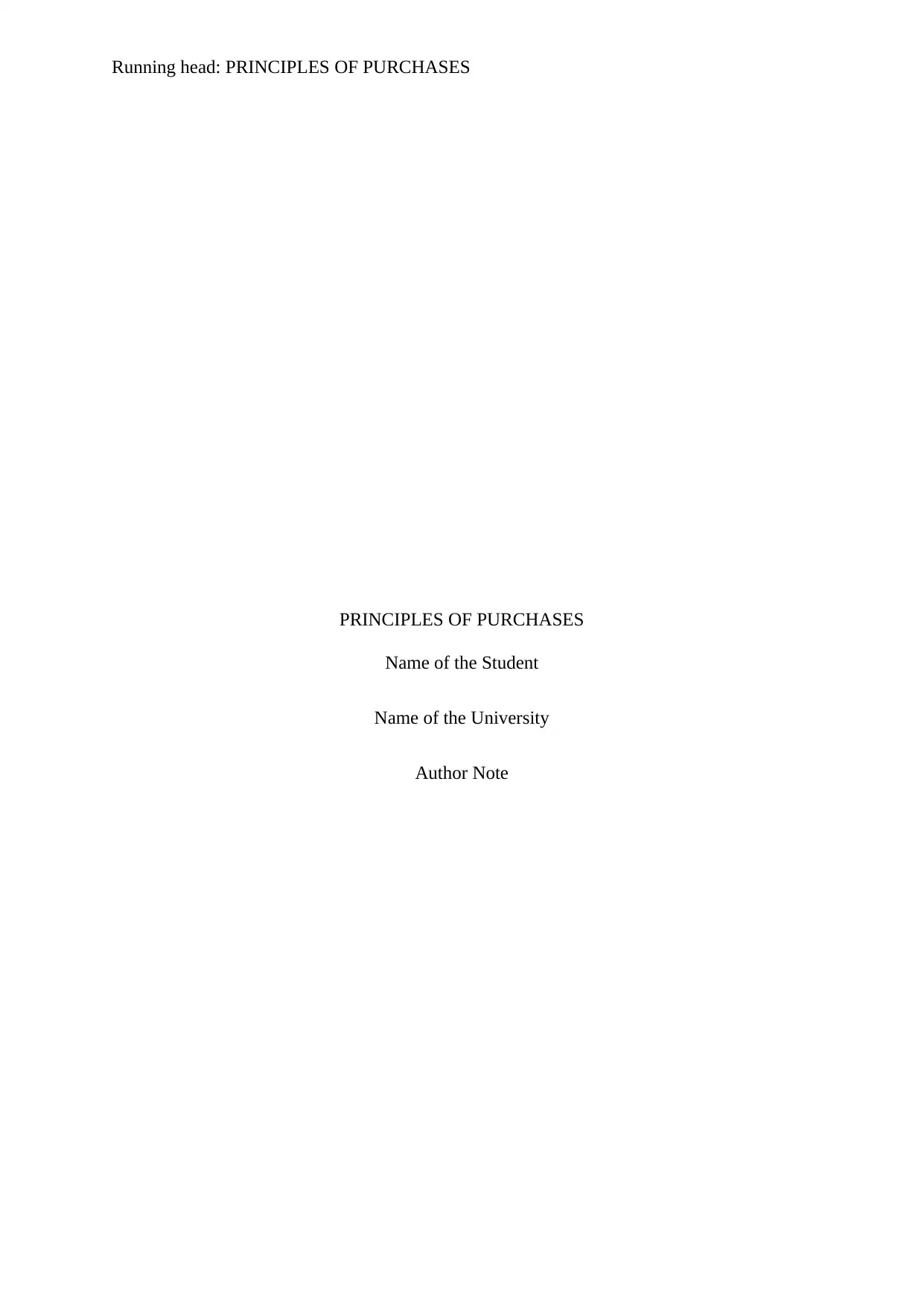
Running head: PRINCIPLES OF PURCHASES
PRINCIPLES OF PURCHASES
Name of the Student
Name of the University
Author Note
PRINCIPLES OF PURCHASES
Name of the Student
Name of the University
Author Note
Paraphrase This Document
Need a fresh take? Get an instant paraphrase of this document with our AI Paraphraser
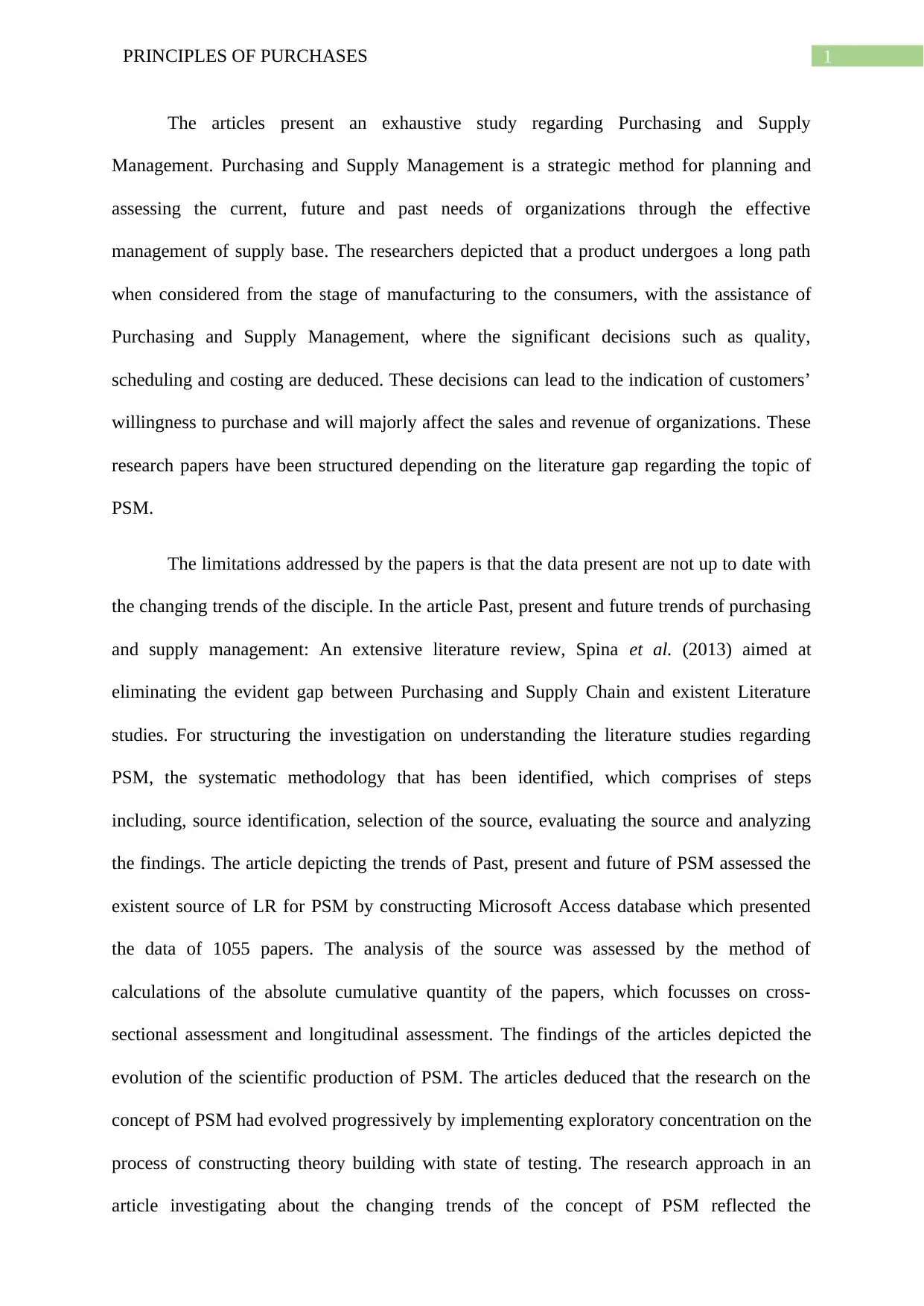
1PRINCIPLES OF PURCHASES
The articles present an exhaustive study regarding Purchasing and Supply
Management. Purchasing and Supply Management is a strategic method for planning and
assessing the current, future and past needs of organizations through the effective
management of supply base. The researchers depicted that a product undergoes a long path
when considered from the stage of manufacturing to the consumers, with the assistance of
Purchasing and Supply Management, where the significant decisions such as quality,
scheduling and costing are deduced. These decisions can lead to the indication of customers’
willingness to purchase and will majorly affect the sales and revenue of organizations. These
research papers have been structured depending on the literature gap regarding the topic of
PSM.
The limitations addressed by the papers is that the data present are not up to date with
the changing trends of the disciple. In the article Past, present and future trends of purchasing
and supply management: An extensive literature review, Spina et al. (2013) aimed at
eliminating the evident gap between Purchasing and Supply Chain and existent Literature
studies. For structuring the investigation on understanding the literature studies regarding
PSM, the systematic methodology that has been identified, which comprises of steps
including, source identification, selection of the source, evaluating the source and analyzing
the findings. The article depicting the trends of Past, present and future of PSM assessed the
existent source of LR for PSM by constructing Microsoft Access database which presented
the data of 1055 papers. The analysis of the source was assessed by the method of
calculations of the absolute cumulative quantity of the papers, which focusses on cross-
sectional assessment and longitudinal assessment. The findings of the articles depicted the
evolution of the scientific production of PSM. The articles deduced that the research on the
concept of PSM had evolved progressively by implementing exploratory concentration on the
process of constructing theory building with state of testing. The research approach in an
article investigating about the changing trends of the concept of PSM reflected the
The articles present an exhaustive study regarding Purchasing and Supply
Management. Purchasing and Supply Management is a strategic method for planning and
assessing the current, future and past needs of organizations through the effective
management of supply base. The researchers depicted that a product undergoes a long path
when considered from the stage of manufacturing to the consumers, with the assistance of
Purchasing and Supply Management, where the significant decisions such as quality,
scheduling and costing are deduced. These decisions can lead to the indication of customers’
willingness to purchase and will majorly affect the sales and revenue of organizations. These
research papers have been structured depending on the literature gap regarding the topic of
PSM.
The limitations addressed by the papers is that the data present are not up to date with
the changing trends of the disciple. In the article Past, present and future trends of purchasing
and supply management: An extensive literature review, Spina et al. (2013) aimed at
eliminating the evident gap between Purchasing and Supply Chain and existent Literature
studies. For structuring the investigation on understanding the literature studies regarding
PSM, the systematic methodology that has been identified, which comprises of steps
including, source identification, selection of the source, evaluating the source and analyzing
the findings. The article depicting the trends of Past, present and future of PSM assessed the
existent source of LR for PSM by constructing Microsoft Access database which presented
the data of 1055 papers. The analysis of the source was assessed by the method of
calculations of the absolute cumulative quantity of the papers, which focusses on cross-
sectional assessment and longitudinal assessment. The findings of the articles depicted the
evolution of the scientific production of PSM. The articles deduced that the research on the
concept of PSM had evolved progressively by implementing exploratory concentration on the
process of constructing theory building with state of testing. The research approach in an
article investigating about the changing trends of the concept of PSM reflected the
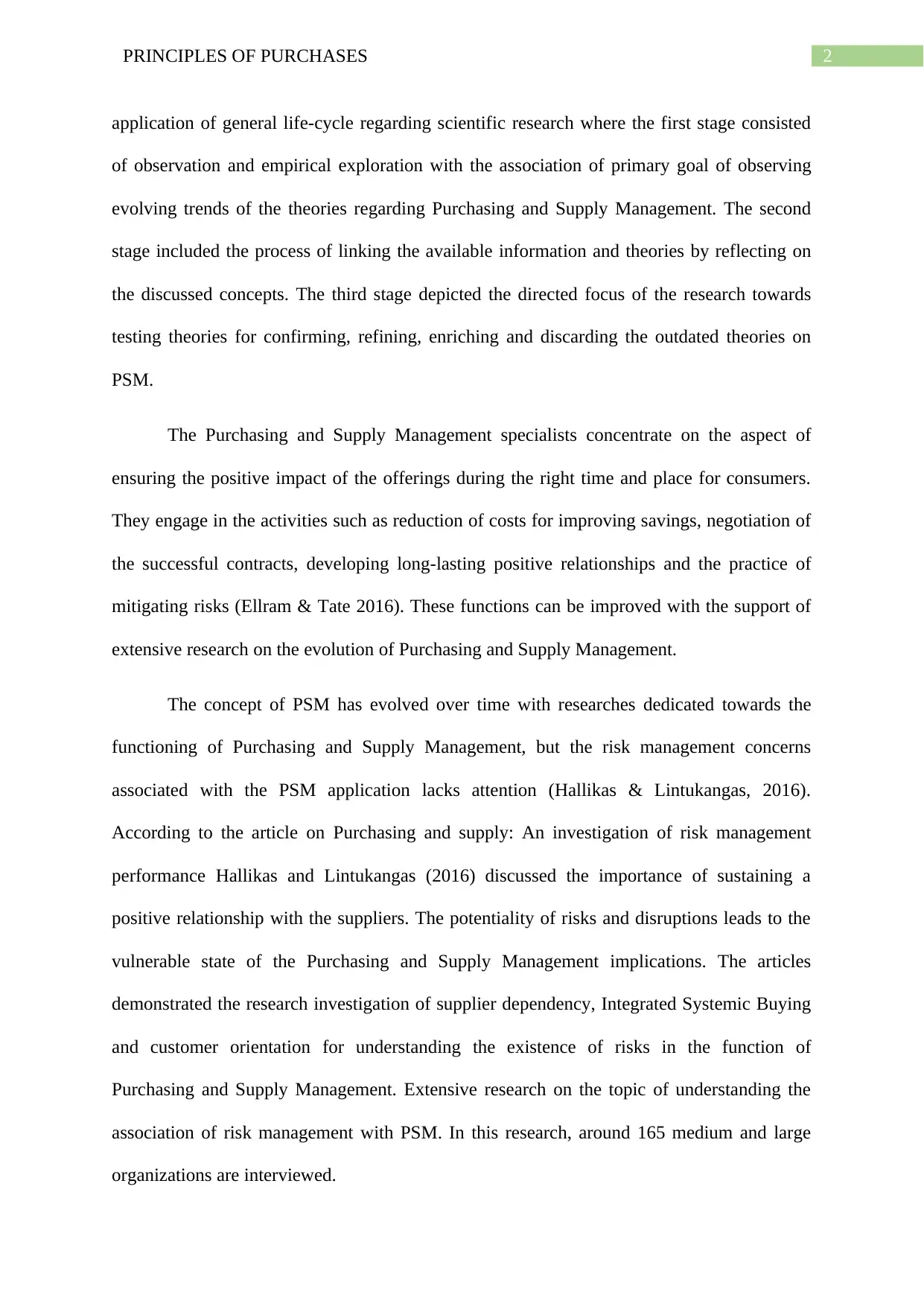
2PRINCIPLES OF PURCHASES
application of general life-cycle regarding scientific research where the first stage consisted
of observation and empirical exploration with the association of primary goal of observing
evolving trends of the theories regarding Purchasing and Supply Management. The second
stage included the process of linking the available information and theories by reflecting on
the discussed concepts. The third stage depicted the directed focus of the research towards
testing theories for confirming, refining, enriching and discarding the outdated theories on
PSM.
The Purchasing and Supply Management specialists concentrate on the aspect of
ensuring the positive impact of the offerings during the right time and place for consumers.
They engage in the activities such as reduction of costs for improving savings, negotiation of
the successful contracts, developing long-lasting positive relationships and the practice of
mitigating risks (Ellram & Tate 2016). These functions can be improved with the support of
extensive research on the evolution of Purchasing and Supply Management.
The concept of PSM has evolved over time with researches dedicated towards the
functioning of Purchasing and Supply Management, but the risk management concerns
associated with the PSM application lacks attention (Hallikas & Lintukangas, 2016).
According to the article on Purchasing and supply: An investigation of risk management
performance Hallikas and Lintukangas (2016) discussed the importance of sustaining a
positive relationship with the suppliers. The potentiality of risks and disruptions leads to the
vulnerable state of the Purchasing and Supply Management implications. The articles
demonstrated the research investigation of supplier dependency, Integrated Systemic Buying
and customer orientation for understanding the existence of risks in the function of
Purchasing and Supply Management. Extensive research on the topic of understanding the
association of risk management with PSM. In this research, around 165 medium and large
organizations are interviewed.
application of general life-cycle regarding scientific research where the first stage consisted
of observation and empirical exploration with the association of primary goal of observing
evolving trends of the theories regarding Purchasing and Supply Management. The second
stage included the process of linking the available information and theories by reflecting on
the discussed concepts. The third stage depicted the directed focus of the research towards
testing theories for confirming, refining, enriching and discarding the outdated theories on
PSM.
The Purchasing and Supply Management specialists concentrate on the aspect of
ensuring the positive impact of the offerings during the right time and place for consumers.
They engage in the activities such as reduction of costs for improving savings, negotiation of
the successful contracts, developing long-lasting positive relationships and the practice of
mitigating risks (Ellram & Tate 2016). These functions can be improved with the support of
extensive research on the evolution of Purchasing and Supply Management.
The concept of PSM has evolved over time with researches dedicated towards the
functioning of Purchasing and Supply Management, but the risk management concerns
associated with the PSM application lacks attention (Hallikas & Lintukangas, 2016).
According to the article on Purchasing and supply: An investigation of risk management
performance Hallikas and Lintukangas (2016) discussed the importance of sustaining a
positive relationship with the suppliers. The potentiality of risks and disruptions leads to the
vulnerable state of the Purchasing and Supply Management implications. The articles
demonstrated the research investigation of supplier dependency, Integrated Systemic Buying
and customer orientation for understanding the existence of risks in the function of
Purchasing and Supply Management. Extensive research on the topic of understanding the
association of risk management with PSM. In this research, around 165 medium and large
organizations are interviewed.
⊘ This is a preview!⊘
Do you want full access?
Subscribe today to unlock all pages.

Trusted by 1+ million students worldwide
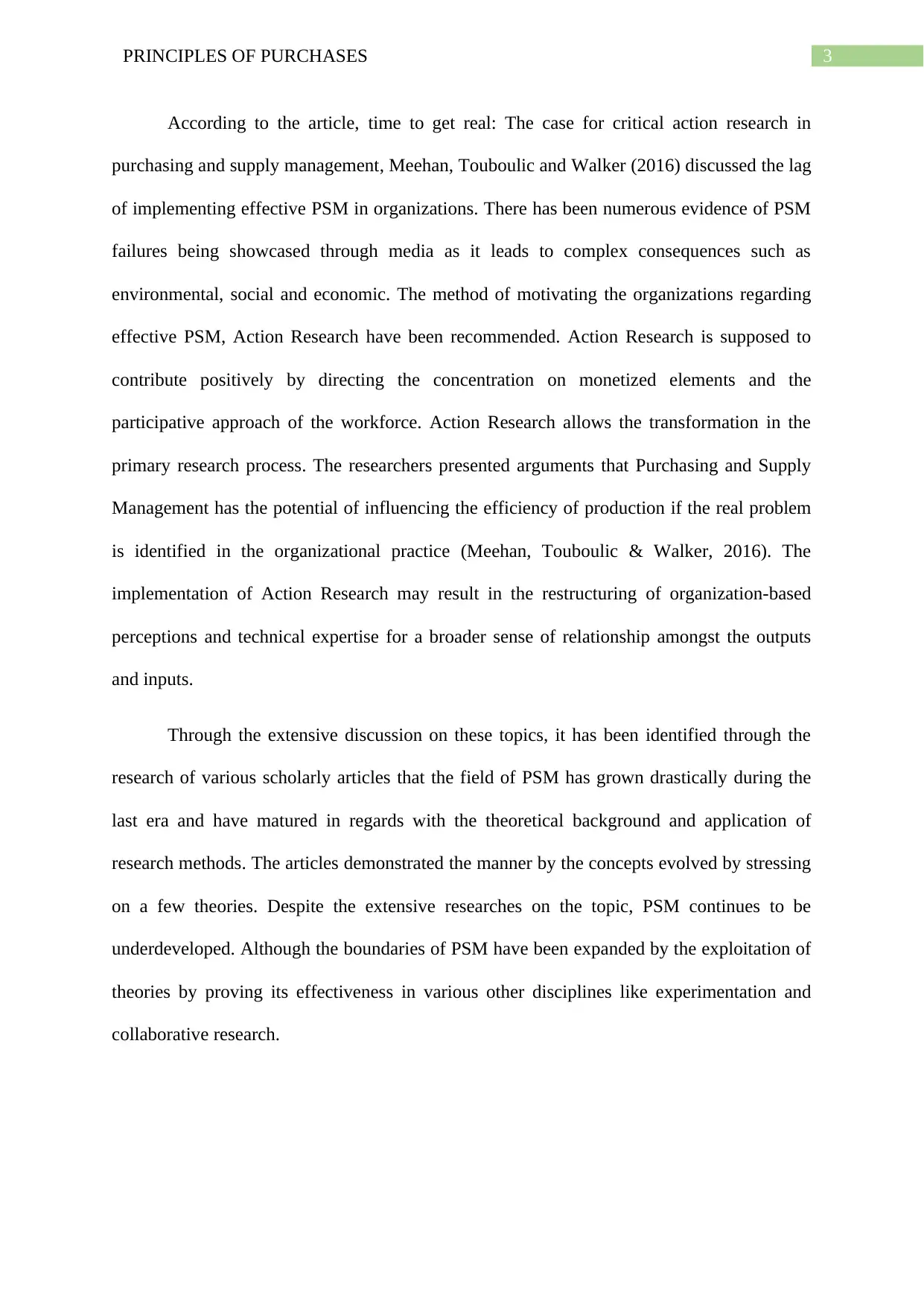
3PRINCIPLES OF PURCHASES
According to the article, time to get real: The case for critical action research in
purchasing and supply management, Meehan, Touboulic and Walker (2016) discussed the lag
of implementing effective PSM in organizations. There has been numerous evidence of PSM
failures being showcased through media as it leads to complex consequences such as
environmental, social and economic. The method of motivating the organizations regarding
effective PSM, Action Research have been recommended. Action Research is supposed to
contribute positively by directing the concentration on monetized elements and the
participative approach of the workforce. Action Research allows the transformation in the
primary research process. The researchers presented arguments that Purchasing and Supply
Management has the potential of influencing the efficiency of production if the real problem
is identified in the organizational practice (Meehan, Touboulic & Walker, 2016). The
implementation of Action Research may result in the restructuring of organization-based
perceptions and technical expertise for a broader sense of relationship amongst the outputs
and inputs.
Through the extensive discussion on these topics, it has been identified through the
research of various scholarly articles that the field of PSM has grown drastically during the
last era and have matured in regards with the theoretical background and application of
research methods. The articles demonstrated the manner by the concepts evolved by stressing
on a few theories. Despite the extensive researches on the topic, PSM continues to be
underdeveloped. Although the boundaries of PSM have been expanded by the exploitation of
theories by proving its effectiveness in various other disciplines like experimentation and
collaborative research.
According to the article, time to get real: The case for critical action research in
purchasing and supply management, Meehan, Touboulic and Walker (2016) discussed the lag
of implementing effective PSM in organizations. There has been numerous evidence of PSM
failures being showcased through media as it leads to complex consequences such as
environmental, social and economic. The method of motivating the organizations regarding
effective PSM, Action Research have been recommended. Action Research is supposed to
contribute positively by directing the concentration on monetized elements and the
participative approach of the workforce. Action Research allows the transformation in the
primary research process. The researchers presented arguments that Purchasing and Supply
Management has the potential of influencing the efficiency of production if the real problem
is identified in the organizational practice (Meehan, Touboulic & Walker, 2016). The
implementation of Action Research may result in the restructuring of organization-based
perceptions and technical expertise for a broader sense of relationship amongst the outputs
and inputs.
Through the extensive discussion on these topics, it has been identified through the
research of various scholarly articles that the field of PSM has grown drastically during the
last era and have matured in regards with the theoretical background and application of
research methods. The articles demonstrated the manner by the concepts evolved by stressing
on a few theories. Despite the extensive researches on the topic, PSM continues to be
underdeveloped. Although the boundaries of PSM have been expanded by the exploitation of
theories by proving its effectiveness in various other disciplines like experimentation and
collaborative research.
Paraphrase This Document
Need a fresh take? Get an instant paraphrase of this document with our AI Paraphraser
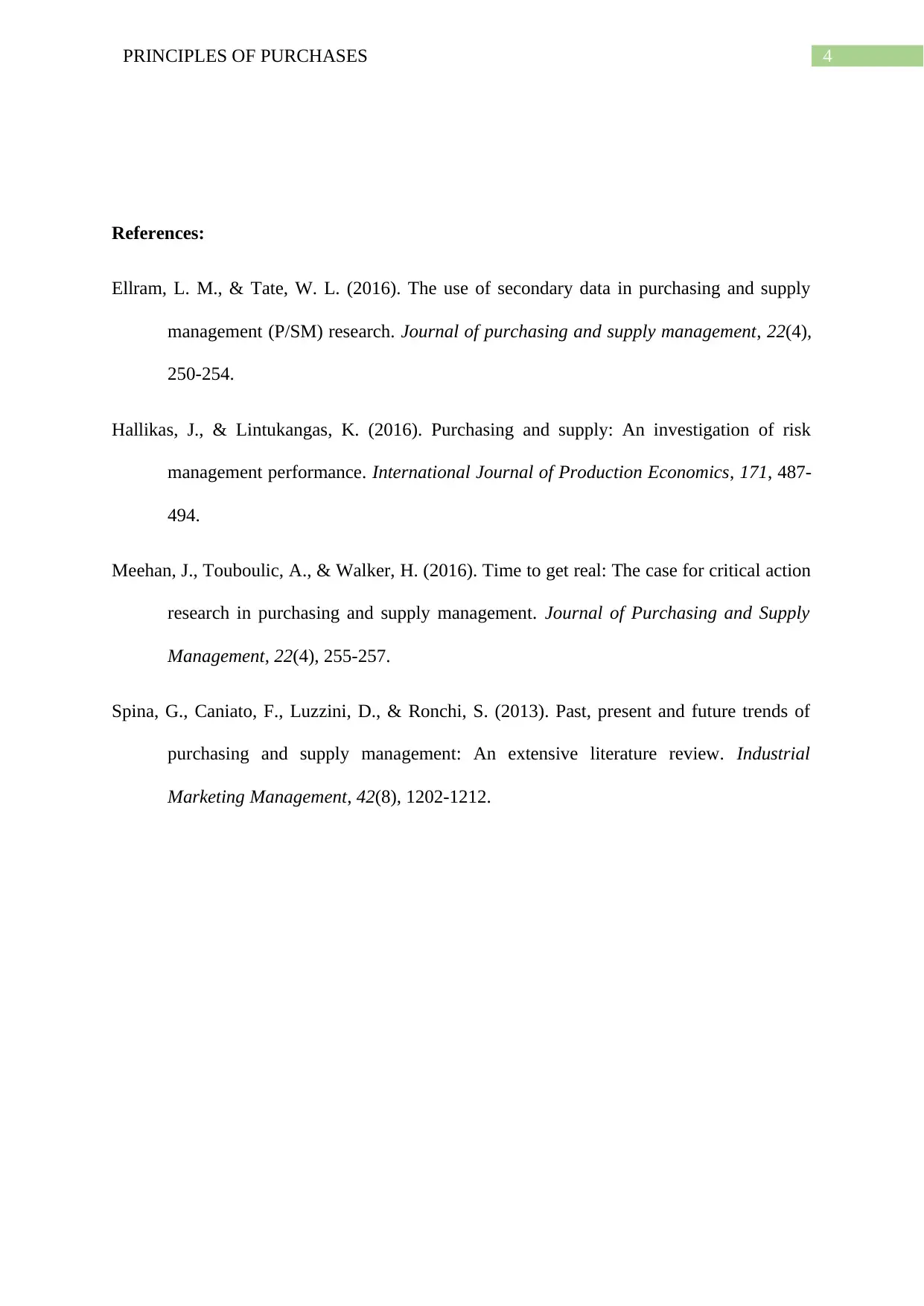
4PRINCIPLES OF PURCHASES
References:
Ellram, L. M., & Tate, W. L. (2016). The use of secondary data in purchasing and supply
management (P/SM) research. Journal of purchasing and supply management, 22(4),
250-254.
Hallikas, J., & Lintukangas, K. (2016). Purchasing and supply: An investigation of risk
management performance. International Journal of Production Economics, 171, 487-
494.
Meehan, J., Touboulic, A., & Walker, H. (2016). Time to get real: The case for critical action
research in purchasing and supply management. Journal of Purchasing and Supply
Management, 22(4), 255-257.
Spina, G., Caniato, F., Luzzini, D., & Ronchi, S. (2013). Past, present and future trends of
purchasing and supply management: An extensive literature review. Industrial
Marketing Management, 42(8), 1202-1212.
References:
Ellram, L. M., & Tate, W. L. (2016). The use of secondary data in purchasing and supply
management (P/SM) research. Journal of purchasing and supply management, 22(4),
250-254.
Hallikas, J., & Lintukangas, K. (2016). Purchasing and supply: An investigation of risk
management performance. International Journal of Production Economics, 171, 487-
494.
Meehan, J., Touboulic, A., & Walker, H. (2016). Time to get real: The case for critical action
research in purchasing and supply management. Journal of Purchasing and Supply
Management, 22(4), 255-257.
Spina, G., Caniato, F., Luzzini, D., & Ronchi, S. (2013). Past, present and future trends of
purchasing and supply management: An extensive literature review. Industrial
Marketing Management, 42(8), 1202-1212.
1 out of 5
Related Documents
Your All-in-One AI-Powered Toolkit for Academic Success.
+13062052269
info@desklib.com
Available 24*7 on WhatsApp / Email
![[object Object]](/_next/static/media/star-bottom.7253800d.svg)
Unlock your academic potential
Copyright © 2020–2025 A2Z Services. All Rights Reserved. Developed and managed by ZUCOL.





